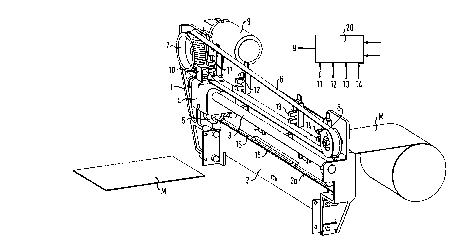Some of the information on this Web page has been provided by external sources. The Government of Canada is not responsible for the accuracy, reliability or currency of the information supplied by external sources. Users wishing to rely upon this information should consult directly with the source of the information. Content provided by external sources is not subject to official languages, privacy and accessibility requirements.
Any discrepancies in the text and image of the Claims and Abstract are due to differing posting times. Text of the Claims and Abstract are posted:
| (12) Patent Application: | (11) CA 2261450 |
|---|---|
| (54) English Title: | CUTTING ARRANGEMENT FOR A MATERIAL WEB |
| (54) French Title: | DISPOSITIF DE COUPE D'UN MATERIAU EN CONTINU |
| Status: | Deemed Abandoned and Beyond the Period of Reinstatement - Pending Response to Notice of Disregarded Communication |
| (51) International Patent Classification (IPC): |
|
|---|---|
| (72) Inventors : |
|
| (73) Owners : |
|
| (71) Applicants : |
|
| (74) Agent: | SMART & BIGGAR LP |
| (74) Associate agent: | |
| (45) Issued: | |
| (22) Filed Date: | 1999-02-10 |
| (41) Open to Public Inspection: | 1999-08-11 |
| Examination requested: | 2004-01-13 |
| Availability of licence: | N/A |
| Dedicated to the Public: | N/A |
| (25) Language of filing: | English |
| Patent Cooperation Treaty (PCT): | No |
|---|
| (30) Application Priority Data: | ||||||
|---|---|---|---|---|---|---|
|
A cutting arrangement for a material web, especially photographic copy
material in
a photographic copier includes a knife roller (5) and a drive (3, 4, 6 to 9)
for
reciprocating the knife roller (5) between two turnaround positions (S1, S4)
transverse to the material web (M) to be cut, to thereby carry out one cut
respectively. At least two starting positions (S1, S2 or S3, S4) are provided
for each
of the two cutting directions which are associated with different widths of
the
material web (M). The drive (3, 4, 6 to 9) commences the cutting movement of
the
knife roller (5) respectively at that starting position (S1, S2 or S3, S4)
associated for
one cutting direction with the respective material web width and moves the
knife
roller (5) after completion of the cut to the respectively closest turnaround
position
(S1, S4) and from thereback to the starting position (S4, S3 or S2, S1)
associated for
the other cutting direction with the respective material web width, provided
that the
latter starting position (S4, S3 or S2, S1) does not coincide with a
turnaround position
(S1, S4). The arrangement of different starting positions for material webs of
different width makes time savings of up to over 50% possible.
Note: Claims are shown in the official language in which they were submitted.
Note: Descriptions are shown in the official language in which they were submitted.

2024-08-01:As part of the Next Generation Patents (NGP) transition, the Canadian Patents Database (CPD) now contains a more detailed Event History, which replicates the Event Log of our new back-office solution.
Please note that "Inactive:" events refers to events no longer in use in our new back-office solution.
For a clearer understanding of the status of the application/patent presented on this page, the site Disclaimer , as well as the definitions for Patent , Event History , Maintenance Fee and Payment History should be consulted.
| Description | Date |
|---|---|
| Inactive: IPC from MCD | 2006-03-12 |
| Inactive: IPC from MCD | 2006-03-12 |
| Inactive: IPC from MCD | 2006-03-12 |
| Inactive: IPC from MCD | 2006-03-12 |
| Inactive: IPC from MCD | 2006-03-12 |
| Time Limit for Reversal Expired | 2006-02-10 |
| Application Not Reinstated by Deadline | 2006-02-10 |
| Deemed Abandoned - Failure to Respond to Maintenance Fee Notice | 2005-02-10 |
| Letter Sent | 2004-01-26 |
| Request for Examination Received | 2004-01-13 |
| All Requirements for Examination Determined Compliant | 2004-01-13 |
| Request for Examination Requirements Determined Compliant | 2004-01-13 |
| Letter Sent | 2002-10-18 |
| Inactive: Cover page published | 1999-08-19 |
| Application Published (Open to Public Inspection) | 1999-08-11 |
| Inactive: IPC assigned | 1999-03-31 |
| Classification Modified | 1999-03-31 |
| Inactive: First IPC assigned | 1999-03-31 |
| Inactive: IPC assigned | 1999-03-30 |
| Inactive: IPC assigned | 1999-03-30 |
| Filing Requirements Determined Compliant | 1999-03-11 |
| Inactive: Filing certificate - No RFE (English) | 1999-03-11 |
| Application Received - Regular National | 1999-03-10 |
| Abandonment Date | Reason | Reinstatement Date |
|---|---|---|
| 2005-02-10 |
The last payment was received on 2003-12-23
Note : If the full payment has not been received on or before the date indicated, a further fee may be required which may be one of the following
Please refer to the CIPO Patent Fees web page to see all current fee amounts.
| Fee Type | Anniversary Year | Due Date | Paid Date |
|---|---|---|---|
| Registration of a document | 1999-02-10 | ||
| Application fee - standard | 1999-02-10 | ||
| MF (application, 2nd anniv.) - standard | 02 | 2001-02-12 | 2001-01-17 |
| MF (application, 3rd anniv.) - standard | 03 | 2002-02-11 | 2002-01-15 |
| Registration of a document | 2002-09-11 | ||
| MF (application, 4th anniv.) - standard | 04 | 2003-02-10 | 2003-01-24 |
| MF (application, 5th anniv.) - standard | 05 | 2004-02-10 | 2003-12-23 |
| Request for examination - standard | 2004-01-13 |
Note: Records showing the ownership history in alphabetical order.
| Current Owners on Record |
|---|
| IMIP LLC |
| Past Owners on Record |
|---|
| MARTIN HELLER |